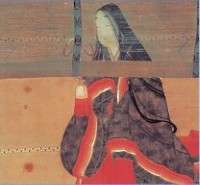The Pillow Book

The Pillow Book (枕草子 Makura no Sōshi) is a book of observations and musings recorded by Sei Shōnagon during her time as court lady to Empress Consort Teishi (定子) during the 990s and early 1000s in Heian Japan. The book was completed in the year 1002.
In it she included lists of all kinds, personal thoughts, interesting events in court, poetry, and some opinions on her contemporaries. While it is mostly a personal work, Shōnagon's writing and poetic skill makes it interesting as a work of literature, and it is valuable as a historical document. Part of it was revealed to the Court by accident during Shōnagon's life. The book was first translated into English in 1889 by T. Purcell and W. G. Aston. Other notable English translations were by Arthur Waley in 1928, Ivan Morris in 1967, and Meredith McKinney in 2006.
Overview
Starting with the "exhaustiveness" of the "collection of similar things" and how it is represented by "as for worms", "as for the flowers of trees", "hateful things", and "things of beauty" – which have been described as "Borgesian lists"[1] – author Sei Shōnagon’s "Ramblings" observed the nature of everyday life and the four seasons, and described in diverse sentences "her recollections" (her diary) that look back at the society of the imperial court surrounding Empress Teishi whom she served, among other things.
Three types of classification were proposed by Kikan Ikeda.[2] However, there are sections that are rather ambiguous and are difficult to classify (e.g., in the first paragraph of her ramblings, "As for Spring, (it is) the dawn [that is lovely]", there are objections to common opinions of what is actually meant here).
It is composed primarily in Japanese hiragana, and generally many of her short stories were written in a witty literary style. Confessions of her personal feelings are mixed into her writing with occasionally subtle sentimentality that reflects the downfall of the emperor’s adviser, Fujiwara no Michitaka (her biological father), as well as the misfortune of both Emperor and Empress Teishi.
Both the author's sophisticated sense and her eye for particular things are fused; for if one compares the sentimentality of mono no aware (the Pathos of Things) as found in "The Tale of Genji", similar beauty of the world is revealed through the use of the intellectual word okashi (lovely) in this piece.
The miscellaneous collection has been arranged loosely into three types, while the collection of similar things has been compiled by distinct classification, and this so-called compiling was done afterwards by the hands of people other than Sei Shōnagon.
In general, this piece is written in brief statements, where the length of one paragraph is relatively short, and it is easy to read the contents, even for modern Japanese speakers.
Other pillow books

More generally, a pillow book is a collection of notebooks or notes which have been collated to show a period of someone or something's life. In Japan such kind of idle notes are generally referred to as the zuihitsu genre. Other major works from the same period include Kamo no Chōmei's Hōjōki and Yoshida Kenkō’s Tsurezuregusa. Zuihitsu rose to mainstream popularity in the Edo period, when it found a wide audience in the newly developed merchant classes. Furthermore, it gained a scholarly foothold, as Japanese classical scholars began customarily writing in the zuihitsu style. Reputable authors from this movement include Motoori Norinaga, Yokoi Yayu, and Matsudaira Sadanobu.[3]
Peter Greenaway released his film The Pillow Book in 1996. Starring Vivian Wu and Ewan McGregor, it tells a modern story that references Sei Shōnagon's work.
The Pillow Book is also the name of a series of radio thrillers written by Robert Forrest and broadcast on BBC Radio 4's Woman's Hour Drama. These are detective stories with Sei Shōnagon as a principal character and feature many of her lists.[4]
See also
- Heian literature
- Nikki bungaku
- The Dog Pillow is an Edo period parody.
References
- ↑ Liza Dalby (1 February 2009). East Wind Melts the Ice: A Memoir Through the Seasons. University of California Press. p. 22. ISBN 978-0-520-25991-1.
- ↑ 池田亀鑑, Complete Lectures on The Pillow Book (全講枕草子』解説), 1957
- ↑ Kodansha Encyclopedia of Japan
- ↑ "Woman's Hour Drama, The Pillow Book, series 3". BBC. Retrieved 16 November 2010.
Bibliography
- Sei Shōnagon (2006). The Pillow Book. trans. Meredith McKinney. London: Penguin Books. ISBN 0-14-044806-3.
- Sei Shōnagon (1971). The Pillow Book of Sei Shōnagon. trans. Ivan Morris. London: Penguin Books. ISBN 0-14-044236-7. Originally published in 1967 by Columbia University Press.
- Sei Shōnagon (2011). The Pillow Book of Sei Shōnagon, the Diary of a Courtesan in Tenth Century Japan. trans. Arthur Waley. Rutland, Vermont: Tuttle Publishing. ISBN 978-4805311080.
- Henitiuk, Valerie (2011). Worlding Sei Shônagon: The Pillow Book in Translation. Ottawa: University of Ottawa Press. ISBN 978-0-7766-0728-3.
External links
| Japanese Wikisource has original text related to this article: |
- English excerpts from The Pillow Book
- Synopses of Robert Forrest's original five radio series
- Synopsis of further radio series by Robert Forrest